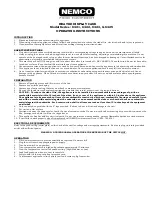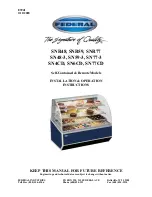
22
190-00607-02 Rev C
Detailed Operation
Custom Map
ILS/Localizer Depiction
When either an ILS or localizer is tuned on the
SL30, the GMX 200 will display the currently tuned
approach on the appropriate airport runway. The SL30
Nav function provides an overall graphic view of the
selected airport and approach based on runway exten-
sions and the selected frequencies. The standard ILS
symbol is shown in magenta on the GMX 200 display.
ILS for currently tuned approach by SL30
Localizer Back Course Display
The GMX 200 will draw the “front course” on its
display when a localizer frequency is tuned into the
SL30. If you enable the localizer back course feature
of the SL30, the GMX 200 will then draw a localizer
“front course” graphic extending from the reciprocal
runway.
The localizer front course graphic is shaded on
the right side. The localizer back course graphic is
shaded on the left side. Since the SL30 reverse-senses
the needles, a standard “chase the needle” approach
may be made and the localizer “front course” graphic
is always used on the GMX 200. A published localizer
back course approach at the airport is not necessary to
enable this feature.
The SL30 must be receiving a valid ILS, or localizer,
and the GMX 200 must have airports turned on for this
feature to be active.
ndBs
The NDBs option allows you to choose the type of
NDB information displayed on the Map screen. You
may select the display of NDB icon and identifier, icon
only, or no information by each subsequent press of
the NDB
MENU ITEM
key.
Intersections
The Intersections option allows you to choose the
type of Intersection information displayed on the Map
screen. You may select the display of the Intersec-
tion icon and identifier, icon only, or no information
by each subsequent press of the Intersection
MENU
ITEM
key. Intersections are drawn when the zoom
scale is 100 NM, or less, and are labeled at 75 NM or
less.
Airspace
The Airspace option allows you to control the dis-
play of airspaces. Pressing the
MENU ITEM
key next
to Airspace toggles between either the display of air-
space boundaries and altitude information, boundaries
alone, or no display of airspaces. Airspaces defined as
Class B, C, Alert, Caution, Danger, Training, Warning,
MOA, Restricted, and Prohibited are depicted on the
display. TFRs, when available from an FIS sensor, are
displayed when Airspaces are enabled. Note that not
all airspaces may be defined in the database as one
of these airspaces. Class D airspaces are not drawn;
however, a circular airspace with a five mile radius is
drawn around airports with control towers. Airspaces
defined as Unknown, such as the Grand Canyon, are






































